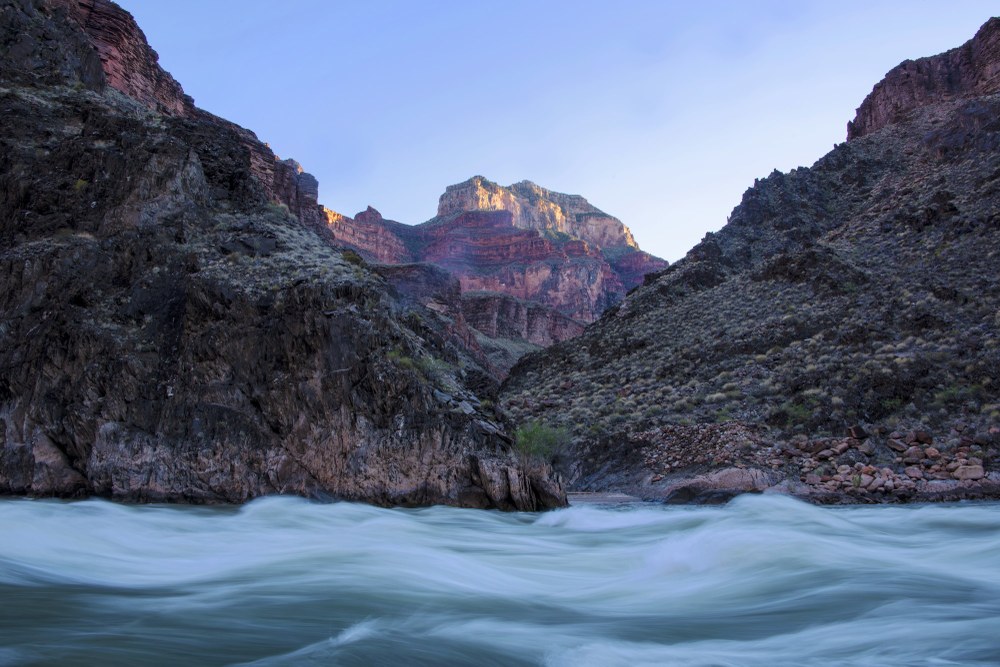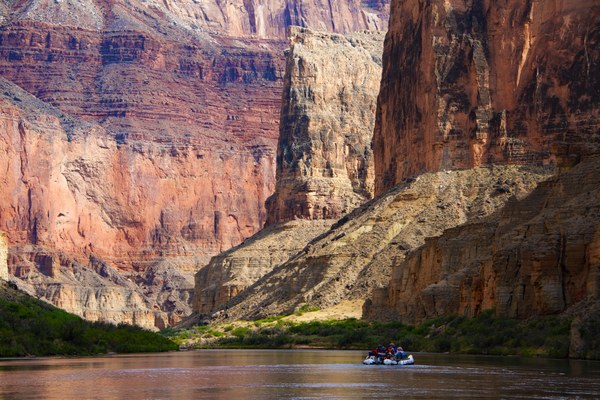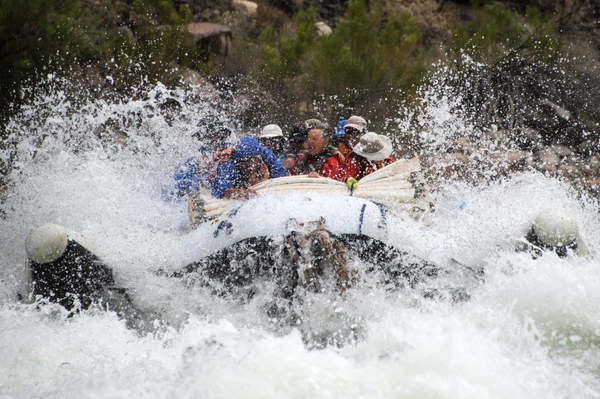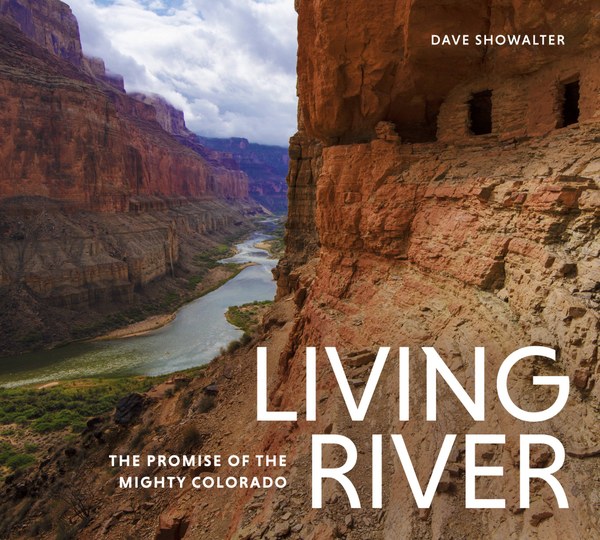
For 6 million years the Colorado River has flowed 1,450 miles from the Rocky Mountains to the Pacific Ocean. But in just a few decades, overallocation of water resources, climate change, and megadrought have altered the great river. In Living River: The Promise of the Mighty Colorado, a new book and campaign from Braided River - the conservation imprint of Mountaineers Books - conservation photographer and author Dave Showalter shares stories from seven years of hiking, biking, rafting, and adventuring through the watershed.
In this abridged excerpt, journey with Dave on a rafting expedition through the Grand Canyon as he ruminates on the rich conservation history of the watershed.
Downstream Through the Grand: The Mighty Colorado
By Dave Showalter
For the Grand Canyon expedition, an eight-day trip in spacious, motorized J-rig boats, we gather in Flagstaff the night before launch to meet the crew for introductions and anxious chatter, then a morning bus ride to the put-in at Lees Ferry, where fully loaded, lashed boats and crew await. Co-leader Abby Burk of Audubon Rockies tells the group to pause and look around, affirming that “water changes everything it touches.” Taking a habitat-first approach to bird conservation, Abby and Alison Holloran dreamed up these river trips to immerse conservation-minded folks in some of the most important remaining habitats in the Colorado River watershed and for each of us to be changed by the experience in our own way.

Floating the Colorado in the Grand Canyon’s inner gorge in two motorized thirty-plus-foot J-Rig rafts. Photo by Dave Showalter.
After head boatman B. J. Boyle gives the safety talk while our crew continues well-practiced preparations, B. J. starts us off with a timeless quote from John Wesley Powell’s legendary first descent of the Green and Colorado Rivers and their canyons for three months in 1869: “We have an unknown distance yet to run, an unknown river to explore. What falls there are, we know not; what rocks beset the channel, we know not; what walls ride over the river, we know not. Ah, well! We may conjecture many things.”
Personal flotation devices are fitted, everyone finds their place, and whoosh: boats push off, and the current caresses and sweeps boats, lives, and mountains of gear downstream. The river is already changing us as we drift further from the put-in. We’ll find a rhythm, become a family by day three, and linger at the Diamond Creek takeout 226 river miles and eight days later, wishing for just a little more time with the river.
The Lees Ferry gauge is across the river from the boat put-in above Marble Canyon and the Grand Canyon, marking the official demarcation of the Upper and Lower Basins in the Colorado River system. Of all the gauges on the river, this is the one that records flow from the Upper Basin to the Lower Basin, the gauge that tells us how much water (measured in acre-feet) Lower Basin states Nevada, Arizona, and California will have each season.
The river is smooth and glassy as we pass under the historic Navajo Bridge (opened to traffic in 1929, providing a new corridor between Utah and Arizona) to enter the soaring white walls of polished limestone in Marble Canyon, so named by Powell. The rolling Badger Creek Rapids make for a gentle introduction to whitewater, with more rapids coming in quick succession: Soap Creek Rapid, Thirteen Mile Rapid, Sheer Wall Rapid, House Rock, each with its own character and lore. Rapids are created when flash floods explode from side canyons, sending rocks and debris tumbling into the inner river gorge, where boulders obstruct flow and narrow the channel.
Camp one is a sandbar at Twenty-Two Mile Wash, and my journal notes Coconino Sandstone towering 1,900 feet overhead. We had started with the Coconino Sandstone seemingly in arm’s reach, giving scale to how deep we’ve dropped in our initiation to the chasm. Deep in the Grand, the inner gorge holds legends and touchstones everywhere - sacred ancestral dwellings, petroglyphs, and granaries of the Ancient Ones, as we’re now enveloped in vibrant 340 million-year-old Redwall Limestone. Yellow-breasted chats and yellow warblers call from willow stands, California condors soar a mile overhead, a peregrine falcon lifts off from a sandbar, desert bighorn sheep drink lustily, bellies bloated.

Legendary Lava Falls Rapid engulfs a J-Rig boat in the downstream reach of the Grand Canyon on the volcanic Toroweap Fault. Photo by Dave Showalter.
At river mile 40, we pass under bolts left behind by survey crews for what would have become the Marble Canyon Dam. In the 1960s, two dams were planned for the Grand Canyon - 110-foot-tall Marble Canyon Dam and 670-foot-tall Bridge Canyon Dam, each with an attendant power plant - and would have inundated most of the Grand. These bolts that once held scaffolding for dam survey crews still cling to canyon walls as reminders of hubris and folly.
Floating through these gorges, I’m mindful of those who came before, founders of the modern conservation movement during the 1950s and ’60s Bureau of Reclamation dam-building frenzy. In 1952 David Brower of the Sierra Club recruited rabble-rouser Martin Litton to resist Echo Park Dam in Dinosaur National Monument. Litton, first as a Los Angeles Times reporter, then founder of Grand Canyon Dories, ran the Colorado River through the Grand Canyon until age eighty-seven and was a lifelong conservationist and wilderness advocate who has called David Brower the “greatest conservationist of all time.” Brower would refer to Litton as his conscience as they first pushed back against Echo Park Dam, appealing to America’s wilderness values in a campaign that included the book This Is Dinosaur: Echo Park Country and Its Magic Rivers, photographed by Philip Hyde and edited and with a contribution by Wallace Stegner.
When Echo Park Dam was stopped, the Colorado River Storage Project, funded and needing storage capacity in the Upper Basin, moved forward with Glen Canyon Dam, which began filling in 1963 until 1980, impounding the Colorado in Lake Powell upstream from the Grand Canyon. The construction of Glen Canyon Dam galvanized the modern environmental movement and the general public in an organized resistance when the Marble Canyon and Bridge Canyon Dams were proposed in the Grand Canyon. Brower and Litton, along with Edward Abbey, were among the leaders who ultimately succeeded in saving the Grand Canyon for future generations.

Living River book cover. Photo by Dave Showalter.
Follow the Living River Journey and Take Action by May 30th!
In 2026 the Colorado River Compact will be renegotiated amid climate change, reduced snowpack, and water shortages, presenting an opportunity to ensure universal access to clean water for more than 30 federally-recognized Native tribes and make the allocation of the Colorado equitable as well as sustainable.
This April and May is also a critical time to be a voice for the river, as the United States Bureau of Reclamation seeks public comment on the Draft Supplemental Environmental Impact Statement (SEIS) to the 2007 Interim Guidelines. This SEIS evaluates different scenarios to better balance water supply in the Colorado River watershed, which will impact ecosystem health in the Grand Canyon and other areas.
The stories, art, and lifeways that deepen our relationships to water are what build the collective voice for the healthy rivers that benefit wildlife and people. The mighty Colorado changes everything it touches, including us. Here's a few ways you can join the Living River conversation.
- Buy a copy of Living River from Mountaineers Books, your local bookstore, or one of these online sellers.
- Attend a book launch multimedia event. The Living River book tour is traveling the West - find an event near you, or join a virtual event.
- Explore the Living River website and follow the journey on Instagram.
- Take Action by May 30th and urge the Bureau of Reclamation to recognize the important links between human health, stable communities, and the environment and to implement measures that better balance water supply and protect the Grand Canyon ecosystem.
Presently, there is less water in the Colorado River system than at any time in recorded history, threatening the vitality of its ecosystem. But wherever there is water, there is abundant, dynamic life. As Dave Showalter says: “The river is not dying. She flows with the same pure purpose as before we arrived."
There’s no giving up on the Colorado for river keepers engaged in riparian restoration. The hard work ahead requires widespread engagement in our future, which begins with all of us asking: Where does our water come from, and who does it connect us to?
Living River: The Promise of the Mighty Colorado is available wherever books are sold. Get your copy from Mountaineers Books, and learn more about the campaign at www.livingrivercolorado.org.
 Erika Lundahl
Erika Lundahl